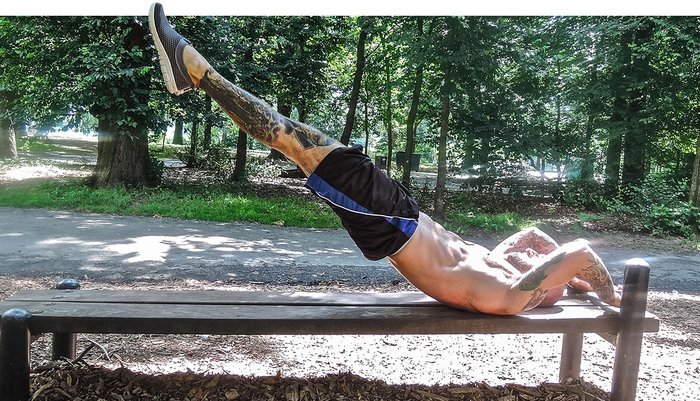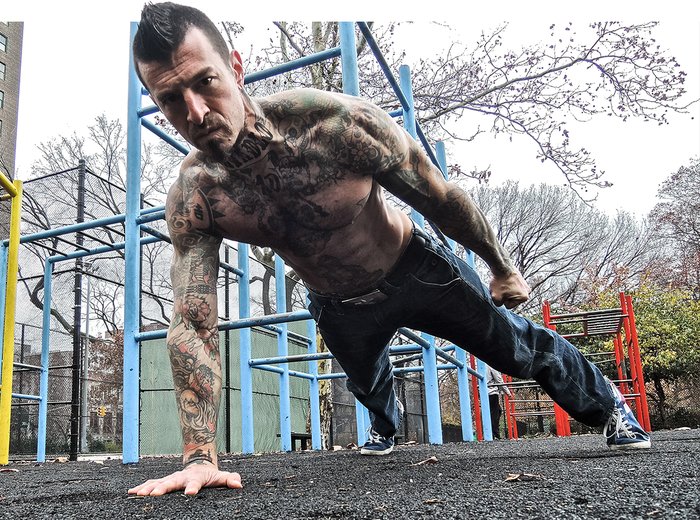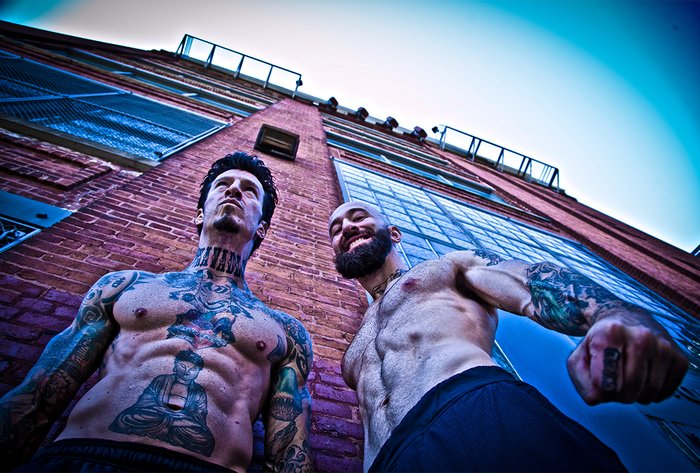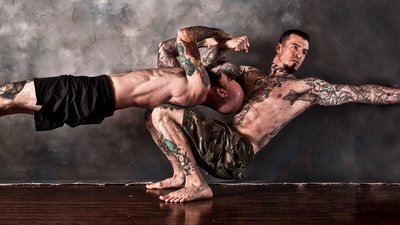Lately, there's been a lot written about calisthenic strength training—enough that, finally, we've come close to reclaiming the word "calisthenics" from the 1980s exercise videos that mostly people have associated with it. But whatever you call it, bodyweight training is hotter than ever.
This modality has existed since the dawn of time and it's being talked about like it's a brand new phenomenon, even though we all know the opposite is true. Before the invention of machines, barbells, and bench presses, mankind was getting strong and ripped using nothing more for resistance than bodyweight. Pressing, pulling, and squatting are hardwired into our DNA. So why is there all this hoopla about calisthenics? Why now?
Some claim it is part of a larger trend toward minimalism in training. Others say it's the feeling of empowerment you get from owning a body that's truly "self-made." Perhaps others are impressed by the unique feats of strength associated with extreme calisthenics. I actually think all of these answers are right, but there's something more, too.
Let's face it: Everybody who works out pays attention to aesthetics to some degree—even if they would never admit to training with that goal. No matter how "functional" or "sport-specific" their training may be, we all react to imagery, and I've found that advanced bodyweight strength training produces a uniquely impressive physique.
What has become known as the "calisthenics body" is easily identifiable by a rippled, muscular build, erect posture, balanced development, and no superfluous body fat. Say what you will, that's what really gets people talking!
The Calisthenic Body Is The Cohesive Body
One of the beautiful things about calisthenics is that we celebrate movements that use the whole body cohesively, rather than attempting to isolate small body parts one at a time.
There's no doubt that different exercises emphasize certain muscles more than others, but let's be clear: 100 percent isolation in any modality is impossible. However, you can still try to isolate. We don't, and the reason is because we know that to do something as difficult as a one-arm pull-up, strong arms and lats aren't enough to get the job done. We need to utilize strength and tension from the entire body.
The principles of calisthenic strength training have a direct physical manifestation, because the strength-to-weight ratio required to perform advanced movements has specific demands. Practitioners of calisthenics develop an ideal balance of muscle mass and body fat that allows for dominance of their own realm. They've got everything they need and nothing more.
The body that results doesn't lie. There are telltale signs. Here's what they are, and how to build them.

Calisthenics Abs
The calisthenics body starts in the middle, because when you train with bodyweight, you use your abs for every single exercise—and it shows! But if we want to get specific, bar-work is where the tell-tale calisthenics abs are built, utilizing movements like full-ROM hanging leg raises and windshield wipers.

A serratus with a steak-knife edge, and the bulging six-pack abs contained within, are the marking of the calisthenics body.
These movements have a direct effect on the trunk's overall appearance, since they rely heavily on the serratus anterior in addition to the muscles you usually think of when you hear the word "abdominals." This has a huge effect by shaping and framing the entire abdominal region. A serratus with a steak-knife edge, and the bulging six-pack abs contained within, are the marking of the calisthenics body.
Calisthenics Arms
Just as with abs, bar work is your best friend when it comes to arms, particularly biceps, which

get a better workout from chin-ups than from all the curls in the world. Because you're pulling far more weight than you would typically curl, the gains are astronomical, and the choices are infinite.
Do them all—overhand pull-ups and underhand chins, wide-grip and narrow, thick bar, switch grip, and hanging from irregular objects—and you'll create amazing tensile strength and powerful connective tissue. Combine the grip training you get from bar work with advanced push-up variations—fingertips, knuckles, back-of-hands—for forearms that would make Popeye jealous.
It can take any number of machine-based isolation-style exercises to hit the arms (and chest and shoulders) from as many angles as good old-fashioned dips. Performed deep, with full range of motion, the results are undeniable. Try as many different hand widths as possible for maximum results. They can also be done on a bench or straight bar. Have some fun!
Calisthenics Back, Shoulders, And Chest
Exceptionally wide lats are a trademark of the calisthenics body. Because we don't attempt to isolate the arms, we have a greater chance of unlocking the genetic potential of our lats through pull-ups, muscle-ups, bar levers, and the human flag. The lats play a huge role in these movements and plenty of others, and their development is a direct result of a varied bodyweight pulling program.
The shoulders are used in all upper body calisthenics strength training and get a substantial workout from every exercise mentioned thus far. The "V" formed by the lats gets even wider when we train handstand push-ups. Even guys who think they can military press massive poundage are often humbled when they attempt this exercise, but if they stick with it, they'll discover that handstand push-ups lead to astronomical gains in the shoulders. Take 'em slow and controlled, and touch your nose to the ground.

The lats play a huge role in these movements and plenty of others, and their development is a direct result of a varied bodyweight pulling program.
Of course, the push-up is the granddaddy of all chest exercises. It can be progressed to deliver a far greater punch than the classic version we all learned in gym class—and which is a spectacular exercise in its own right. But it's tragic to stop there when we can play with inclines, limit points of contact, or increase range of motion. All of these methods employ progressive techniques to build a thick, hard, powerful chest. That chest will be your prize once you master the one-arm push-up, which combines balance, stability, increased range of motion, and muscular overload in one exercise.
Calisthenics Legs
Critics of calisthenics love to perpetuate the falsehood that bodyweight athletes have underdeveloped legs. Ironically, these are the same unfounded jabs that have rocked the weightlifting community at large for years. There are many ways to skin a cat, and we all have more in common than apart. No matter how you choose to work out, everybody's legs need training!
Take it from me: When you train your legs using only bodyweight, they get strong! And it's not from external resistance, but rather from manipulating gravity and doing complete movement patterns. Bodyweight squats go all the way to the ground—ass to ankles. I'm more concerned with building strength through the full expression of a movement than from overloaded half-reps where the hamstring never touches the calf.
Try doing 40 bodyweight squats all the way down. If that sounds easy, do it anyway just to make sure. And if it iseasy, then try doing five more... on just one leg! Exercises like pistol squats exploit our inborn sense of balance, which many of us have lost track of over the years. To own this movement, you must push, pull, and stabilize using all your leg muscles, in a perfect marriage of strength and mobility.
Back bridging, another calisthenics staple, requires further recruitment of hamstrings, glutes, and spine erectors. Raw strength and supreme flexibility combine to define the backside of a bodyweight warrior.
Confidence
This one is harder to quantify than the others, but I know it when I see it. Any red-blooded man or woman who is sure that they could pull their body up—or press it through the floor, or hold it strong at any angle—conducts themselves with a certain quiet cool that cannot be explained. You can call it "relative strength," but there's something objectively inspiring about it.
The posture and physique is unmistakable. When you know your own pound-for-pound power and truly own the calisthenics body, you stand tall!

